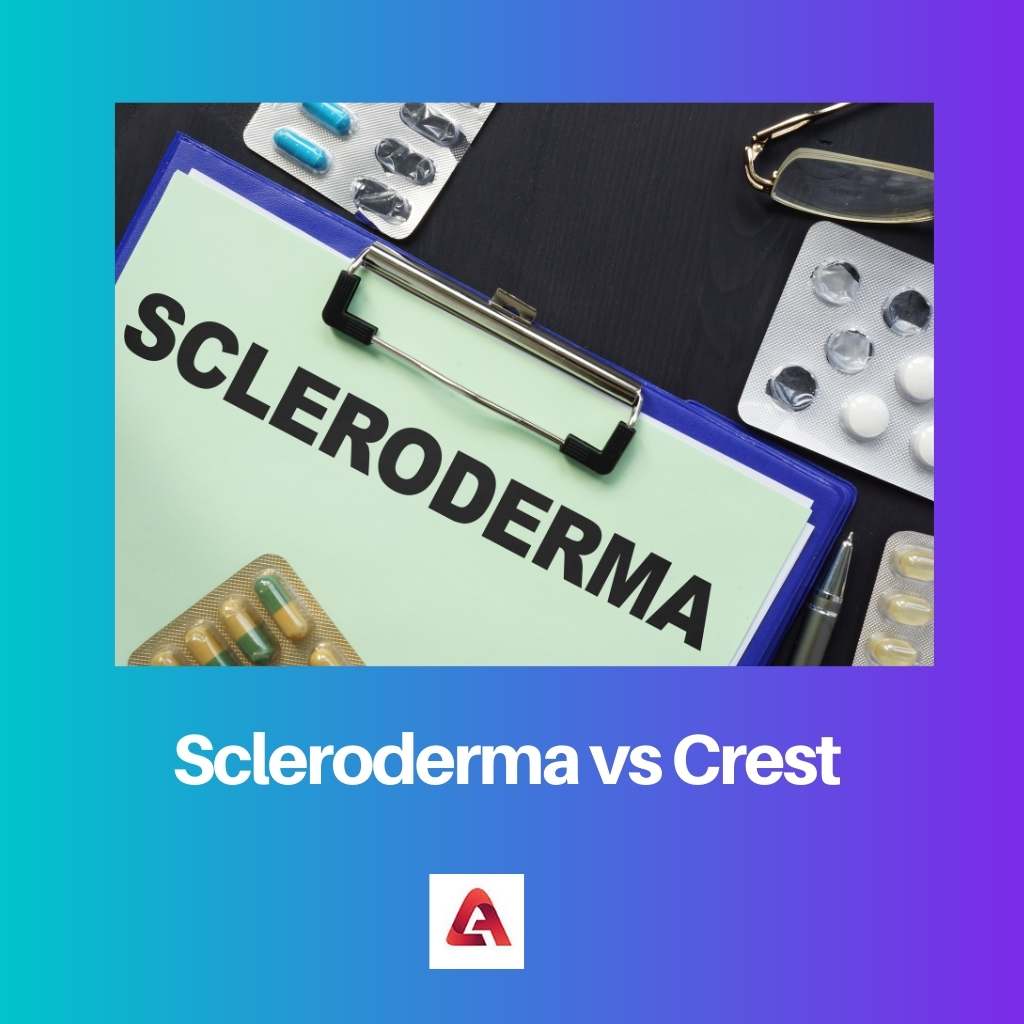Among all the diseases found in mankind, one is called Scleroderma. It is most likely to happen that certain people have not even heard this particular name, but in reality, this disease can be found in many people.
However, it has certain types, among which one is known as Crest. It is possible that sometimes these two diseases are used interchangeably, but it is important to note that there are a number of differences between these two that are important to notice.
Key Takeaways
- Scleroderma is a chronic autoimmune disease causing abnormal growth of connective tissue, while CREST syndrome is a subtype of scleroderma with specific symptoms.
- CREST stands for Calcinosis, Raynaud’s phenomenon, Esophageal dysfunction, Sclerodactyly, and Telangiectasia.
- Scleroderma can affect internal organs, while CREST primarily affects the skin and blood vessels.
Scleroderma vs Crest
Scleroderma is a chronic autoimmune disease that causes thickening and hardening of the skin and other connective tissues throughout the body. CREST syndrome is a subset of scleroderma that stands for Calcinosis, Raynaud’s phenomenon, Esophageal dysmotility, Sclerodactyly, and Telangiectasia.

Scleroderma is a disease that is widely recognized in the field of medical science. The major reason that has been recognized behind this disease is the poor immunity of a certain body part of an individual. A person who is suffering from this particular disease happens to notice certain abnormal changes in his body and skin.
But on the other hand, Crest is not a separate disease in itself. Rather it is a variety found under Scleroderma. The major difference is that Crest focuses on certain high-intensity features of this particular disease that are noticed to affect certain body parts only. It majorly affects the skin of the diseased and leaves certain abnormal internal marks on the affected part of the skin. It operates on a certain body territory only; therefore, it is also known as limited scleroderma.
Comparison Table
| Parameters of Comparison | Scleroderma | Crest |
|---|---|---|
| Meaning | A type of disease that falls under the family of auto-immune diseases. | A variety of Scleroderma and also a member of the family of auto-immune diseases. |
| Affected areas | Skin majorly | Skin, esophagus, etc. |
| Symptoms | Some symptoms are- skin thickening, feeling tired always, having a blood flow that is very poor, etc. | Some symptoms are- visible blood vessels on hands and legs, manufacturing of calcium deposits in certain tissues, having difficulty in swallowing things. |
| Causes | It occurs majorly either because of poor immune response of the body or exposure to silica. | It occurs majorly because the body had made certain antibodies that it was not supposed to make. |
| First founded by | In the year 1753 by Carlo Curzio. | R.H. Winterbauer in the year 1964. |
What is Scleroderma?
In the year 1753, certain unique symptoms of a particular disease were told to the world by a scientist named Carlo Curzio. However, it was not until the year 1842 that these symptoms, along with the disease, were documented and found properly.
The disease was given the name Scleroderma. The term belongs to the Greek language and denotes simply a skin that has been hardened. Scleroderma is a disease that belongs to a definite family of diseases called auto-immune diseases. It mainly affects the skin of the person and sometimes affects the blood pressure also.
Even after tons of research being conducted on this disease, its definite cause is still unknown; however, due to some research, it is said that this disease occurs as a result of the poor immune response of certain body parts of an individual. Apart from this immunity factor, genetics also slightly contribute to the growth of this disease, and it is also believed that if a person is exposed to silica more, he is more likely to catch this disease.

What is Crest?
The crest, also known as the Crest syndrome, happens to be a member of the auto-immune disease family and falls under the umbrella of Scleroderma itself. In other words, it is just a variety of Scleroderma and not a different disease in itself.
In the year 1964, R.H. Winterbauer, who was just a medical student at that time, told the world that he had found a combination of certain symptoms that could make a completely new disease. Further, as medical science saw progress, research was conducted on this disease, and it was named Crest.
The major feature that differentiates Crest from Scleroderma is the symptoms it has. The following are the symptoms of Crest syndrome-
- It can cause some thickening in certain tissues because of the deposits of calcium in that disease. These tissues become somewhat visible on the affected body part.
- It can cause complications in the esophagus, such as trouble swallowing food or having a kind of severe pain.
- It can cause exhaustion in the affected person
- It can be the reason behind lack of breath or delay in the healing of wounds.
Main Differences Between Scleroderma and Crest
- Scleroderma is a disease that comes under the family of auto-immune diseases, while on the other hand, Crest is more of a disease that falls under the purview of Scleroderma itself.
- Scleroderma affects the skin of the diseases mainly, while on the other hand, Crest affects not only the skin but the esophagus and other body parts as well.
- Scleroderma mostly occurs because of the poor immune system or over-exposure to silica, while on the other hand, Crest can be a result of the body producing certain anti-nuclear antigens.
- Scleroderma can have symptoms like- skin thickening, feeling tired always, having a blood flow that is very poor, etc. While on the other hand, Crest can have symptoms like- visible blood vessels on hands and legs, manufacturing of calcium deposits in certain tissues, having difficulty in swallowing things.
- Scleroderma was first founded and explained as a disease by Carlo Curzio in the year 1753. While on the other hand, Crest was, for the very time, described by R.H. Winterbauer in the year 1964.



